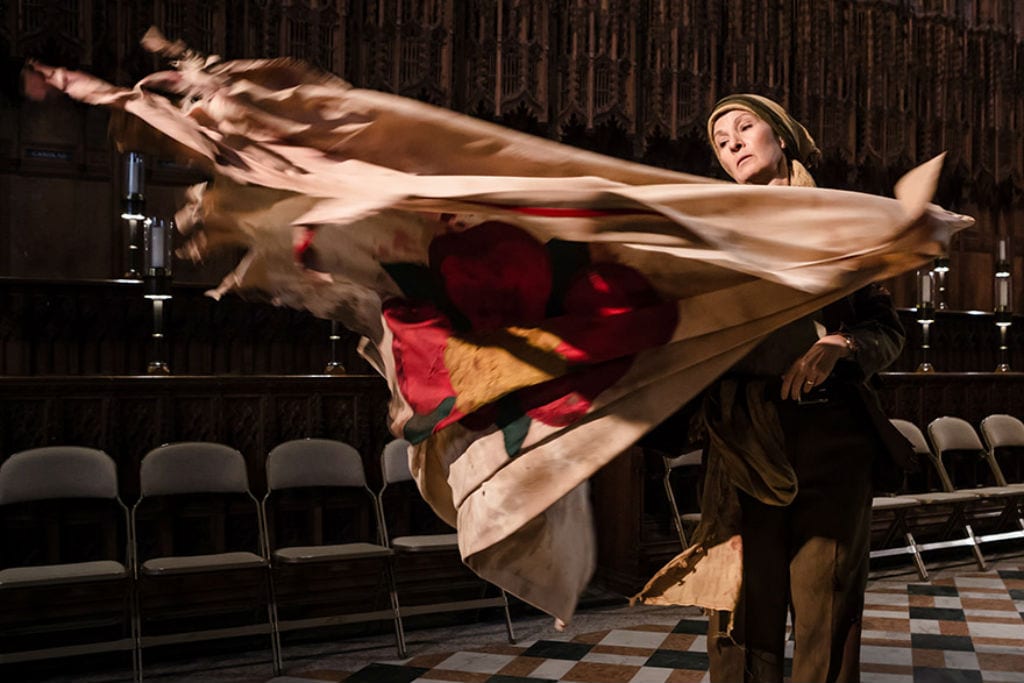Antic Disposition have honed the historical contextualization of Shakespeare to a fine art. After a remarkable tour of Henry V last year, they have done the same in 2017 with Richard III, taking in a series of venues in France, a selection of English Cathedrals (including Leicester, Richard’s final resting place), and finally the Temple Church, whose fine natural acoustic and setting next to the garden where the Wars of the Roses allegedly began, could hardly be more apt.
This is hardly a play that lacks performances, yet this production is one that no enthusiast for Shakespeare should miss. There is a consistent and imaginative attention to the text and to the dynamics of characterisation which re-thinks and presents anew what is often thought familiar.
Set on a traverse stage between the pews in the main body of the church, the action is pacey and deftly coordinated. The central catwalk leaves little scope for scenery, but we don’t need more than the representation of a coffin, table or throne, and splashes of colour and ceremony are introduced in the modern-dress costumes as needed, not least by getting the audience involved in a little flag-waving. Composer James Burrows has put together an atmospheric score to provide both interlude and underscore, a combination of acoustic keening and a genuinely medieval sound world, that offers fine support to the players.
Too often this play either has a great central performance with inadequate supporting casting, or vice versa. The great strength of this production is the balance it has in both. With some ingenious doubling up of roles there are really no weak links here, with the tiny cavil that both Queen Elizabeth and the Lady Anne could be more vocally varied and feisty in the crucial verbal jousts with Richard.
Otherwise, the acting is of rare verve and consistency. The particular quality of Toby Manley’s Richard is the layering of his performance, which starts off full of low-key, insinuating, but creepy charm, and grows into a full palette of cruelty, cynical wit, raw courage and carefully calculated viciousness. Again it is a tribute to the fine ensemble playing that much of that cruelty stems from Manley’s representation of Richard’s uncanny understanding of the neediness of the other characters, as projected from his own sense of primal hurt.
Among the other players several stand out. The play opens with Queen Margaret lamenting over the draped coffin of her son. Louise Templeton, in battered battle fatigues, thereafter wanders in and out of the action, in real time and outside of it, offering a choric commentary less manic but more sarcastic and rueful than usual. Every word is made to count in a role that – incredibly – is still quite often cut. Joe Eyre’s Buckingham creates a relationship with Richard that describes a beautiful arc of imagined friendship between two master publicists, the one ultimately outlasting and outbidding the other. Eyre is smarmy and slick when on the make and then shrivels memorably when he fails in the take.
Though the role of Clarence is over and done with early on, William de Coverly gave it full and impressive measure. His account of Clarence’s dream anticipating his drowning painted the phantasmagoric picture for us in new verbal colours, and his desperate pleas to his murderers had rare force and poignancy. Alex Hooper did all that could be expected with Richmond and Rivers, and Robert Nairne was a notably sinister Catesby, the archetypal necessary man for whichever regime happens to be in power.
This company has produced another signal triumph in what is quite simply the best production of this particular play to come into town in many a year. Take every opportunity to catch it while you can.




